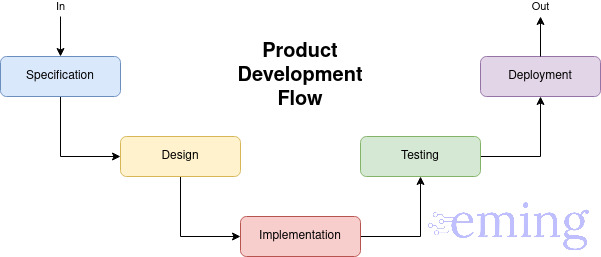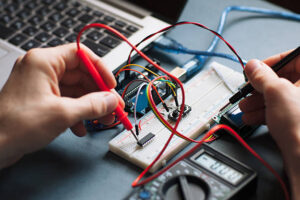Contact us
Embedded Engineering and Product Development
We do embedded engineering, but what exactly is that?. We also do product development in the hardware/electronics side, what does that cover? Here you will get some answers about this interesting topic and our perspective.
Other Engineering in the world?
Embedded Engineering in a strict way is just a made-up name to refer to a specific engineering work. It can be taken as a sub-sub branch of electrical engineering or a field in computer science. This “field” works with electronic devices based on computers at a deep level of integration and optimization. It involves knowledge of circuit analysis, electronics fundamentals, computer architecture, programming, and more.
You can encounter embedded engineers from the hardware and software sides. But these are just categories for jobs: embedded software engineer, embedded hardware engineer, firmware engineer, etc. Finally, this field is electronics at its purest level, from power management to RF systems through computer and digital circuits.
This is a broad field for specific devices. These devices can be quite complex, so it is necessary to know about different disciplines. The final goal of embedded engineering is simple: create optimal devices for specific purposes.
A professor at University said that optimal is a unique and final state, there are no superlatives. As an ideal and theoretical goal it is perfect. Professional electronics always seeks the best path, but in real life there is always room for improvement. In fact, this is also true even in embedded systems that are supposed to be technically designed with this requirement as a flag.
Is Product Development related?
At this point we have seen that embedded engineering has a lot of different areas inside. You can specialize in PCB design for processor systems, programming Microcontrollers, power circuit design for battery devices, and the list goes on and on. All of those areas are also involved in product development. That is because a big chunk of embedded systems are thought of as individual products, despite the other portion that is designed to be part of a larger system.
Product development itself is a big discipline with highly educated people in it. From the technical to the commercial side it involves a lot of different things. With these glasses you do not only see the boards, codes and renders, you have to also see user experience, use cases, manufacturing, costs, suppliers and distributors, etc.
That can be overwhelming to do, but the end goal is to get a product that can solve a real need for people or companies. With this in mind, the goal is “reduced” to think about the user and the value that the product can provide.
So, for us product development is the excuse to do embedded engineering to create those specialized devices. We work to solve problems with technological products that have a real use. For this, we follow a methodology from the sea of frameworks and processes that exist out there to do a lot of things.
Methodology demystified
We love simple things and straightforward processes, so we work in accordance with this. We divide the product development process in 5 stages that are related as shown in the image below.

Inside each one of these stages there are different processes with inputs and outputs (deliverables). But this approach is more related or focused on the engineering side of the equation. Particular tasks like doing market research or selling strategy are not particularly stressed here.
This flow allows us to address projects with different scopes, complexities and challenges in a modular and flexible way. It is crucial that the goals are clear from the beginning of the process in the Specification phase. Later, we can take that initial approach and improve the product iteratively, but the foundation is the same and the process can be started again.
Obviously each product is different and particular. We can structure and organize the projects with this framework to easily track and manage the specific ones. We can build PoC, prototypes and mass-production products following the process and building on what has been previously built.
For the specific area of development (hardware and firmware) we have the engineering flow explained here and here with way more detail and explanation.

